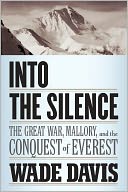One of the most persistent tropes of our impoverished Gitmo conversation is the notion that the base represents a fall from grace for the United States—a radical and shameful break, post-9/11, with the nation’s legal and political tradition. As Jonathan Hansen reminds us in his valuable but frustrating book about Guantánamo Bay, which traces Spanish, French and US involvement there from the late fifteenth century through the present, history indicates the opposite.The rest is here.
The New York Times covers Into the Silence: The Great War, Mallory, and the Conquest of Everest (Knopf), by "National Geographic explorer-in-residence" Wade Davis. "With their empire in tatters, postwar Britons were desperate for a source of renewal to pierce their collective mourning; they needed grand projects to restore national pride. They looked eastward, and up."
Readers interested in the history of photography will want to check out the New Republic review of Carleton Watkins: The Complete Mammoth Photographs (J. Paul Getty Trust Publications), by Weston Naef and Christine Hult-Lewis. "Watkins," in reviewer Jed Perl's estimation, "is the spirit of nineteenth-century California." The book is thus "a portrait of a man’s work" and also of "a time and a place."
A new issue of the New York Review of Books is out. Joseph Lelyveld's review of Condoleeza Rice's memoir is open access. But if you want to know how "China G[ot] Religion!" or whether Shakespeare was prejudiced, you'll have to subscribe.
For those who prefer history on a grander scale, check out The Great Sea: A Human History of the Mediterranean (New York: Oxford University Press, 2011), by David Abulafia, reviewed this week, here, in the National Interest.
This time of year, my dad sets up a vast collection of light-up, porcelain Dickens Village houses. According to History Today, the tiny residents of the village would approve: see the magazine's review of Magpies, Squirrels and Thieves: How the Victorians Collected the World (Atlantic Books), by Jacqueline Yallop (here).


